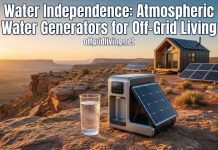For some, going off grid involves the latest technology and all the modern conveniences they can afford, so long as they are generating their own power. For others, it is about going back to a simpler way of life, maybe with some technology to be able to still exist in the modern world to some degree, maybe not, living off the land, and getting away from the hustle and bustle of the world around us.
Going off grid is personal and it diverse, suited to one’s individual goals and needs. If you fall into the “simpler way of life” group, and even if you don’t actually, there are some key skills that will make sure that you can survive long term, one of which, is learning to preserve your own food.
Many people who live an off grid lifestyle, no matter their use of technology, tend to have a garden so they can grow at least some of their own food. With that, a good skill to learn is how to can, or otherwise preserve what you grow for use when your crops are no longer in season.
Canning is an age old method, one that many of our grandparents probably used growing up as a way of life. It is a great way to save your excess fruits and vegetables without them going to waste, and you can turn them into jams, jellies, pickle them, and more, which of course gives you more options than the simple fruit or veggie you started with.
Canning can be done with minimal supplies, all of which are usually fairly easy to find in grocery stores, online, or at speciality shops. If you’re lucky you may be able to find most of what you need from family who may have grandma’s old canning supplies collecting dust in the basement(If that is the case please give them a thorough cleaning).
These are the basic items you’ll need:
*Canning Jars and lids. Classic Ball Jars are the most common, but there are other brands. You can find them at many grocery stores brand new, or you can find the jars at thrift shops, yard sales, and various sites like Craigslist or even Facebook Market.
You’ll want to use new lids though, at least to start with. This way you know where they have been and what they have been used for. (yes you can clean them but better safe than sorry and they are only a few bucks).
*A water bath canner is a specific to canning pot essentially. You can also just use any large pot with a lid. You’ll need this to boil the water to place your jars in in order to properly seal them.
You should also have a canning rack to go into your canner/pot. Letting the jars rest directly on the bottom makes it more likely that they will crack in the process.
*A jar lifter. This is essentially a set of specially designed tongs, and while you can try to use tongs, the jar lifters are more stable and will help keep you from dropping hot, glass jars..so it is best to get a decent jar lifter rather than finding some makeshift method.
Then depending on what you are going to preserve, you may also need:
another large pot or dutch oven to cook your ingredients in.
Pectin for making jams and jellies
A stir stick (chopsticks will work) to get rid of air bubbles in your almost finished product
A timer to help make sure you are letting things cook/boil/set for the required time. You want to get this right so you can enjoy the fruits of your labor without worry.
A canning funnel. These are designed to work with canning jars and not get clogged up, while still reducing spillage.
Plenty of clean towels (canning can be a messy process and you’ll want to clean as you go as much as possible)
And really just fairly common kitchen supplies, sharp knives, mixing bowls, strainers, tongs, etc. It all depends on what you are canning, and if you are doing pickled recipes you will need to check those for any specific items that may make that easier.
Overall, it will take some investment if you are starting with almost nothing, but it will easily pay for itself once you are well stocked on a variety of home canned food that can get you through the entire year.
There are plenty of tutorials and instructions available online or in old fashioned book form. Do your research, gather your supplies, and enjoy!
In future articles we will also talk about drying meats and making fermented foods and drinks for health benefits, so stay tuned!














